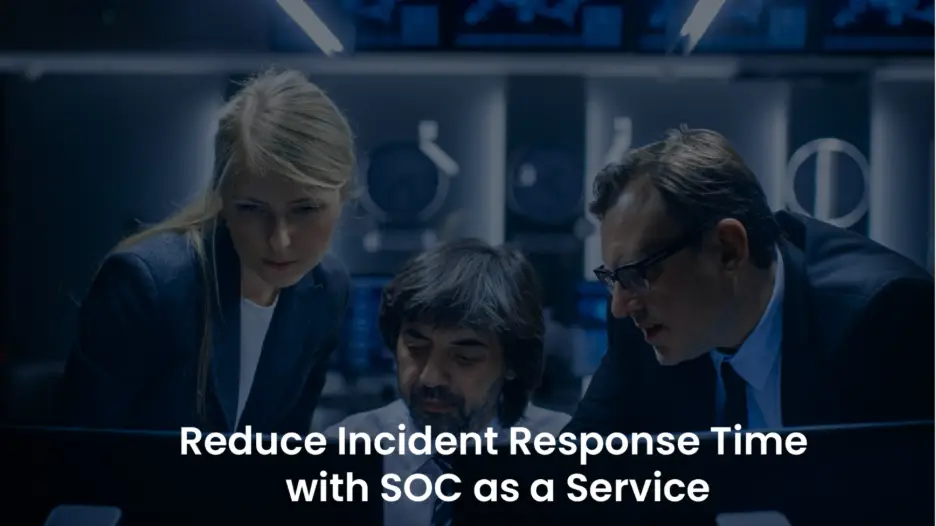
Before diving into the intricacies of SOC as a Service (SOCaaS), it is essential to thoroughly grasp the fundamental concept of a Security Operations Center (SOC), which encompasses its vital functions, capabilities, and the critical role it plays in protecting an organization’s digital infrastructure. This foundational understanding emphasizes the importance of SOCaaS.
This article explores how SOC as a Service significantly reduces incident response times by detailing its importance, best practices, and key performance indicators such as MTTD (Mean Time to Detect) and MTTR (Mean Time to Respond). It elaborates on the continuous monitoring capabilities of SOCs, the implementation of automated triage processes, and the coordination of responses across cloud and endpoint environments. Additionally, it illustrates how integrating SOCaaS with existing security infrastructures enhances visibility and fortifies cybersecurity resilience. This article will provide readers with valuable insights into how a robust SOC strategy, regular drills, and effective threat intelligence contribute to quicker containment of incidents while highlighting the benefits of utilizing managed SOC services to leverage expert analysts, sophisticated tools, and scalable processes, avoiding the need for in-house capability development.
Proven Strategies to Effectively Minimize Incident Response Times with SOC as a Service
To effectively minimize incident response times through the use of SOC as a Service (SOCaaS), organizations must align their technology, processes, and specialized knowledge to quickly identify and mitigate potential threats before they escalate into serious issues. A dependable managed SOC provider integrates continuous monitoring, advanced automation, and a highly skilled security team, enhancing each stage of the incident response lifecycle and ensuring a proactive approach to cybersecurity management.
A Security Operations Center (SOC) acts as the central command for an organization’s cybersecurity framework. When provided as a managed service, SOCaaS combines essential components such as threat detection, threat intelligence, and incident management into a unified system, thereby enabling organizations to respond to security incidents in real-time and effectively manage vulnerabilities.
Effective strategies for minimizing response times include:
- Continuous Monitoring and Detection: By utilizing cutting-edge security tools and SIEM (Security Information and Event Management) platforms, organizations can efficiently analyze logs and correlate security events across diverse endpoints, networks, and cloud services. This proactive real-time monitoring offers a comprehensive view of emerging threats, substantially decreasing detection times while helping to prevent potential breaches before they occur.
- Automation and Machine Learning: SOCaaS platforms leverage the capabilities of machine learning to automate routine triage tasks, prioritize critical alerts, and initiate predefined containment strategies. This level of automation reduces the time that security analysts spend on manual investigations, allowing for quicker and more efficient incident responses, which is crucial in today’s fast-paced cyber threat landscape.
- Skilled SOC Team with Defined Roles: A managed response team consists of seasoned SOC analysts, cybersecurity professionals, and incident response specialists, all operating with clearly defined roles and responsibilities. This structured methodology ensures that every alert receives prompt and appropriate attention, ultimately enhancing the overall incident management process and reducing time to resolution.
- Integrated Threat Intelligence and Proactive Hunting: Engaging in proactive threat hunting, supported by global threat intelligence, helps early identification of suspicious activities, thereby reducing the risk of successful exploitation and fortifying overall incident response capabilities. This approach is critical in preempting cyber threats before they can cause damage.
- Unified Security Stack for Enhanced Coordination: SOCaaS consolidates a variety of security operations, threat detection, and information security functions under a single provider. This integration fosters improved coordination among security operations centers, leading to quicker response times and reduced resolution times for incidents, ultimately enhancing security effectiveness.
The Essential Role of SOC as a Service in Minimizing Incident Response Time
Here’s why SOCaaS is indispensable:
- Continuous Visibility: SOC as a Service provides real-time visibility across endpoints, networks, and cloud infrastructures, enabling the early detection of vulnerabilities and unusual behaviors before they result in significant security breaches. This visibility is crucial for maintaining a proactive security posture within an organization.
- 24/7 Monitoring and Swift Response: Managed SOC operations work around the clock, meticulously analyzing security alerts and events. This constant vigilance ensures rapid incident responses and the quick containment of cyber threats, thus enhancing the overall security posture of the organization and minimizing potential damages.
- Access to Expert Security Teams: Partnering with a managed service provider allows organizations to tap into a pool of highly trained security experts and incident response teams. These professionals can effectively assess, prioritize, and respond to incidents in a timely manner, significantly alleviating the financial burden associated with maintaining an in-house SOC.
- Automation and Integrated Security Solutions: SOCaaS incorporates advanced security solutions, analytics, and automated response playbooks to streamline incident response strategies, greatly reducing delays that can occur due to human intervention in threat analysis and remediation processes.
- Enhanced Threat Intelligence Capabilities: Managed SOC providers leverage global threat intelligence to proactively anticipate emerging risks within the evolving threat landscape, thereby strengthening an organization’s defenses against potential cyber threats and ensuring a more resilient security posture.
- Improved Overall Security Posture: By integrating automation with expert analysts and scalable infrastructure, SOCaaS empowers organizations to maintain a robust security posture, effectively addressing contemporary security challenges without overextending internal resources.
- Strategic Alignment for Enhanced Focus: SOC as a Service enables organizations to focus on strategic security initiatives while the third-party provider manages daily monitoring, detection, and threat response activities, thereby effectively reducing the mean time to detect and resolve incidents.
- Real-Time Management of Security Incidents: Integrated SOC monitoring and analytics provide a comprehensive overview of security events, enabling managed security services to identify, respond to, and recover from potential security incidents with remarkable efficiency and effectiveness.
Best Practices to Enhance Incident Response Time with SOCaaS
Here are the most impactful best practices:
- Establish a Comprehensive SOC Strategy: Clearly defining structured processes for detection, escalation, and remediation is essential. A well-articulated SOC strategy ensures that each stage of the incident response process is executed efficiently across various teams, significantly enhancing overall effectiveness and response times.
- Implement Continuous Security Monitoring: Ensure that security monitoring is conducted 24/7 across all networks, endpoints, and cloud environments. This proactive approach facilitates early detection of anomalies, thereby significantly reducing the time required to identify and contain potential threats before they escalate into serious issues.
- Automate Incident Response Workflows for Efficiency: Integrating automation within SOC solutions expedites triage, analysis, and remediation processes. Automation minimizes the necessity for manual intervention while enhancing the quality and speed of response operations, ultimately leading to reduced incident response times.
- Leverage Managed Cybersecurity Services for Scalability: Collaborating with specialized cybersecurity service providers allows organizations to seamlessly scale their services while ensuring expert-led threat detection and remediation without the operational challenges of maintaining an in-house SOC.
- Conduct Regular Threat Simulations for Preparedness: Executing simulated attacks, such as DDoS (Distributed Denial of Service) drills, helps evaluate an organization’s security readiness. These simulations identify operational gaps and refine incident response processes, thereby enhancing overall resilience against cyber threats.
- Enhance Data Security and Visibility Across Systems: SOCaaS platforms consolidate telemetry from various systems, providing unified visibility into network, application, and data security layers. This comprehensive perspective significantly shortens the timeframe between detection and containment of threats, thus improving incident response capabilities.
- Integrate SOC with Existing Security Tools for Cohesion: Aligning current security tools and platforms within the managed SOC ecosystem helps dismantle operational silos and improves overall security outcomes, fostering a more collaborative and responsive security environment.
- Adopt Solutions Compliant with Industry Standards: Partnering with reputable vendors, such as Palo Alto Networks, allows organizations to integrate standardized security solutions and frameworks that enhance interoperability while minimizing occurrences of false positives in threat detection.
- Measure and Optimize Incident Response Performance Continuously: Regularly monitoring key performance metrics, including mean time to detect (MTTD) and mean time to respond (MTTR), helps identify opportunities to reduce delays in response cycles and enhance the maturity of SOC operations, thereby improving overall security effectiveness.
The Article Reduce Incident Response Time with SOC as a Service Was Found On https://limitsofstrategy.com

